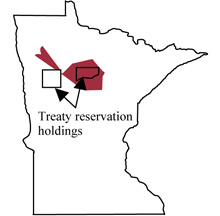1867 Treaty with the Chippewa of the Mississippi
Signed March 19, 1867 in Washington, D. C.
This treaty was engineered to concentrate the Ojibwe population in a single place, encourage them to farm through the allotment of land to individuals, and open valuable pine forests to logging. Individual band members were given scrip to be redeemed for up to 160 acres each, located within boundaries established in the treaty. Mixed blood individuals could receive scrip only if they lived within reservation boundaries, and in no case could the scrip be transferred to “any person not a member of the Chippewa tribe.” In compensation for ceding about 2,000,000 acres, the Ojibwe received $145,000, all in the form of goods and services to support education and farming, payable in various forms over a period of up to 10 years.
Over the following decades, the provisions of this treaty were abused and changed by legislation to transfer ownership of reservation lands from the control of Ojibwe people. Through legislation such as the Dawes Act and Nelson Act, lands were made available for sale to white settlers and timber interests. The Clapp rider in the early 1900's made it legal for mixed blood band members to sell their land scrip, which led to widescale fraud in which no benefits were gained for the sale.
The importance of timber interests in engineering this treaty can be found in the presence of Joel B. Bassett at the treaty signing. Serving as the U.S. Indian agent for the Ojibwe at Crow Wing (1865-1869), Basset had been a lumber manufacturer in Minneapolis since 1850, and this treaty expanded his business. By the late 1880’s, he was convicted of fraudulently harvesting 17,000,000 feet of timber from the White Earth reservation.





